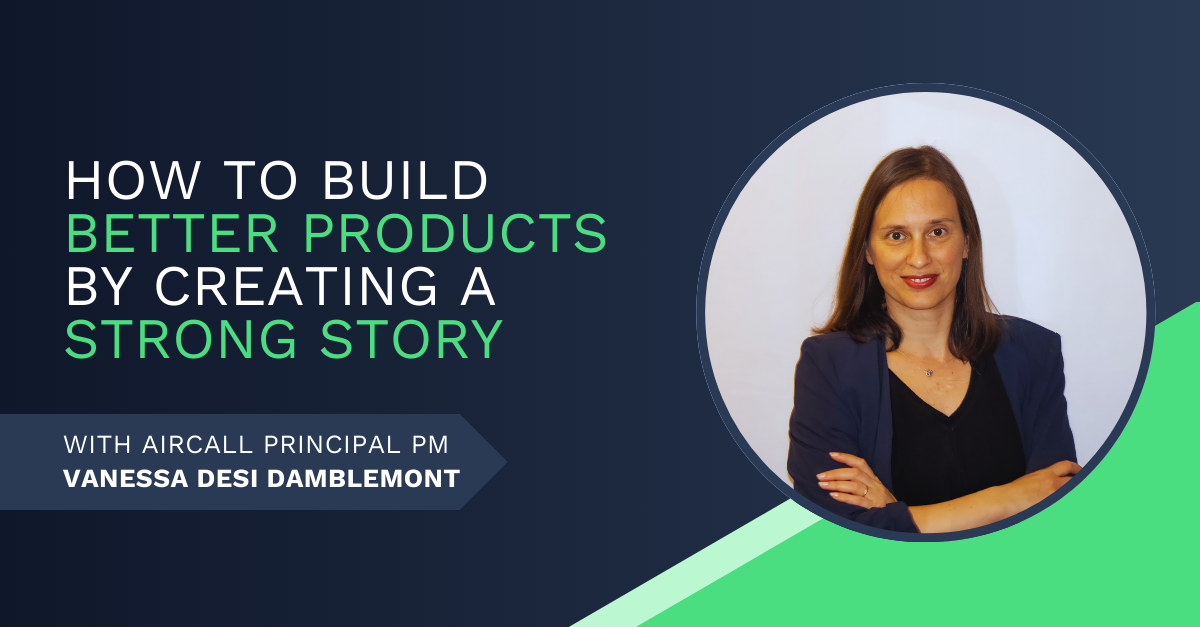
In this thought leadership article, I’m speaking with senior product manager, Vanessa Desi Damblemont, about how product managers can build better products by crafting a strong product story. Vanessa has spent years managing products for everything from SMBs to large enterprise customers, and in this article she is sharing her best practices and advice for product managers who want to improve their decision-making process.
One of the challenges many product managers face when involving customers in their decision-making process is that their product might have many companies using it and within those companies many users.
When it comes to involving users and customers in the decision-making process, Vanessa recommends balancing different feedback sources to get a more comprehensive understanding.
When you have many customers and users using your product, you want to avoid getting biased by only focusing on a few customer interviews. I always try to balance feedback from different sources and customers. I go through feedback provided through our feedback buttons, tickets raised to support, notes from customer success managers, and conduct customer interviews.
But when do you have enough customer feedback to make a product decision? According to Vanessa, you have to collect feedback until you start seeing a key direction to solve a problem:
I collect feedback, bottom-up, until I have enough evidence to see a key direction for solving a problem. Then, I try to match the key direction with everything I know to make sure I haven’t forgotten anything. Afterwards, I will refine and iterate on the solution, then craft a short and clear story about what it does.
And there’s a really good reason behind why Vanessa starts building the story around the solution early in the process:Creating a story around what you are building gives you a long-term direction and helps the people you’re interacting with get more connected to the vision. It gives a common view of where you’re going and provides something people can easily buy into.
According to Vanessa, it’s important to craft a story that will make people excited to follow you. But as she also mentions, you need to do your homework and never start by presenting a blank page:
Creating a story is an interactive and collaborative process. But I had a manager a long time ago that gave me great advice: ‘Never start from a blank page, always have something to showcase.’ So make sure you always have something to start off with. Just start, do something to craft the narrative. Look at your data, do some quick user interviews. So I really try to apply that method of working. In France, we have a saying that says, ‘Say something wrong and you get to the truth.’ Because if you say the wrong things and talk with enough smart people, then at some point you get to the truth.
However, this approach of seeking the truth is not only helpful in building a strong product story, it also helps drive awareness and decision-making in the process.
When you involve people in the process, you build a certain level of confidence in what you have discovered. And by interacting with the right stakeholders and creating visibility, they will also be able to tell you if they believe you are wrong or going in the wrong direction early on, instead of too late.
In this pursuit of not starting from a blank page and getting to the truth, one thing to keep in mind is the influence of your own intuition as a product manager. Vanessa believes product managers need to be aware that their intuition is always part of the process.
You always make a decision about how much data and what kind of effort you put into understanding a specific problem. In fact, even before you get the data, you already have an idea in mind. Maybe the data will change your mind, or maybe it will help you get a better understanding. So what’s important is to have an iterative mindset. When you have no data, what do you think about this problem and why? And then when you have the data, how does it change your thinking and why? At some point, your views on the problem get stronger and stronger and help you create a strong story.
But what do you do when you craft a strong story and stakeholders disagree with the solution you come up with? How do you handle that disagreement?
It depends. But generally, it is important to always have a mindset of being as objective as possible and do your best to understand the rationale behind the disagreement. Be open minded to the fact that sometimes you can be wrong. Always remember that it is your job to give as much clarity and information as needed to make the right decision. And more importantly, always remind stakeholders that not making a decision is in fact a decision by itself, and that not making a decision can have real consequences for our customers, users and business.
While many bottlenecks on decision making can often be resolved in a timely manner, sometimes situations may arrive that are hard to unblock. For those situations Vanessa recommends thinking beyond the decision at hand:
The biggest problem is when people completely disagree with each other and are misaligned. There can be different things that are at stake at different levels. It’s not always about the solution. Sometimes it’s something unresolved in the company strategy and then you need to escalate to people involved in more high-level discussions.
What’s one piece of advice you would like to give to other product managers and aspiring product managers?
It’s important that you like people. You will spend so much time interacting with people in groups, individually, and so on, and you will never be perfect at dealing with people. So it’s important to genuinely like people, get to know them well, and appreciate that everyone has a role to play. Never forget to be nice to people. This job simply has too much people interaction to only focus on figures and documents. Embrace the people and everything else will become easier in the role.


